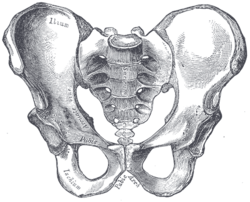Forensic anthropology
| Part of a series on |
| Forensic science |
|---|
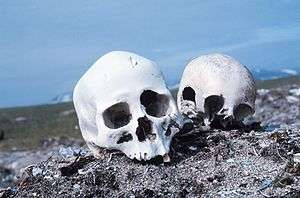 |
|
Forensic anthropology is the application of the anatomical science of anthropology and its various subfields, including forensic archaeology and forensic taphonomy,[1] in a legal setting. A forensic anthropologist can assist in the identification of deceased individuals whose remains are decomposed, burned, mutilated or otherwise unrecognizable, as might happen in a plane crash. Forensic anthropologists are also instrumental to the investigation and documentation of genocide and mass graves. Along with forensic pathologists, forensic dentists, and homicide investigators, forensic anthropologists commonly testify in court as expert witnesses. Using physical markers present on a skeleton, a forensic anthropologist can potentially determine a victim's age, sex, stature, and ancestry. In addition to identifying physical characteristics of the individual, forensic anthropologists can use skeletal abnormalities to potentially determine cause of death, past trauma such as broken bones or medical procedures, as well as diseases such as bone cancer.
The methods used to identify a person from a skeleton relies on the past contributions of various anthropologists and the study of human skeletal differences. Through the collection of thousands of specimens and the analysis of differences within a population, estimations can be made based on physical characteristics. Through these, a set of remains can potentially be identified. The field of forensic anthropology grew during the twentieth century into a fully recognized forensic specialty involving trained anthropologists as well as numerous research institutions gathering data on decomposition and the effects it can have on the skeleton.
Modern uses
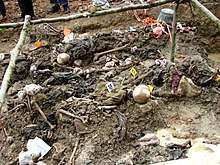
Today, forensic anthropology is a well established discipline within the forensic field. Anthropologists are called upon to investigate remains and to help identify individuals from bones when other physical characteristics which could be used to identify a body no longer exist. Forensic anthropologists work in conjunction with forensic pathologists to identify remains based on their skeletal characteristics. If the victim is not found for a lengthy period of time or has been eaten by scavengers, flesh markers used for identification would be destroyed, making normal identification difficult if not impossible. Forensic anthropologists can provide physical characteristics of the person to input into missing person databases such as that of the National Crime Information Center in the US[2] or INTERPOL's yellow notice database.[3]
In addition to these duties, forensic anthropologists often assist in the investigation of war crimes and mass fatality investigations. Anthropologists have been tasked with helping to identify victims of the 9/11 terrorist attacks[4] as well as plane crashes such as the Arrow Air Flight 1285 disaster[5] and the USAir Flight 427 disaster where the flesh had been vaporized or so badly mangled that normal identification was impossible.[6] Anthropologists have also helped identify victims of genocide in countries around the world, often long after the actual event. War crimes anthropologists have helped investigate include the Rwandan Genocide[7] and the Srebrenica Genocide.[8] Organizations such as the Forensic Anthropology Society of Europe, the British Association for Forensic Anthropology, and the American Society of Forensic Anthropologists continue to provide guidelines for the improvement of forensic anthropology and the development of standards within the discipline.
History
Early history
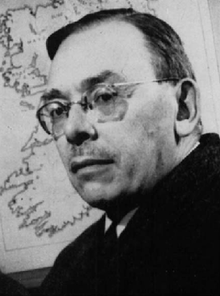
The use of anthropology in the forensic investigation of remains grew out of the recognition of anthropology as a distinct scientific discipline and the growth of physical anthropology. The field of anthropology began in the United States and struggled to obtain recognition as a legitimate science during the early years of the twentieth century.[9] Earnest Hooton pioneered the field of physical anthropology and became the first physical anthropologist to hold a full-time teaching position in the United States.[10] He was an organizing committee member of the American Association of Physical Anthropologists along with its founder Aleš Hrdlička. Hooton's students created some of the first doctoral programs in physical anthropology during the early 20th century.[11] In addition to physical anthropology, Hooton was a proponent of criminal anthropology.[12] Now considered a pseudoscience, criminal anthropologists believed that phrenology and physiognomy could link a person's behavior to specific physical characteristics. The use of criminal anthropology to try to explain certain criminal behaviors arose out of the eugenics movement, popular at the time.[13] It is because of these ideas that skeletal differences were measured in earnest eventually leading to the development of anthropometry and the Bertillon method of skeletal measurement by Alphonse Bertillon. The study of this information helped shape anthropologists' understanding of the human skeleton and the multiple skeletal differences that can occur.
Another prominent early anthropologist, Thomas Wingate Todd, was primarily responsible for the creation of the first large collection of human skeletons in 1912. In total, Todd acquired 3,300 human skulls and skeletons, 600 anthropoid skulls and skeletons, and 3,000 mammalian skulls and skeletons.[13] Todd's contributions to the field of anthropology remain in use in the modern era and include various studies regarding suture closures on the skull and timing of teeth eruption in the mandible. Todd also developed age estimates based on physical characteristics of the pubic symphysis. Though the standards have been updated, these estimates are still used by forensic anthropologists to narrow down an age range of skeletonized remains.[14] These early pioneers legitimized the field of anthropology, but it was not until the 1940s, with the help of Todd's student, Wilton M. Krogman, that forensic anthropology gained recognition as a legitimate subdiscipline.
The growth of forensic anthropology
During the 1940s, Krogman was the first anthropologist to actively publicize anthropologists' potential forensic value, going as far as placing advertisements in the FBI Law Enforcement Bulletin informing agencies of the ability of anthropologists to assist in the identification of skeletal remains. This period saw the first official use of anthropologists by federal agencies including the FBI. During the 1950s, the U.S. Army Quartermaster Corps employed forensic anthropologists in the identification of war casualties during the Korean War.[12] It was at this time that forensic anthropology officially began. The sudden influx of available skeletons for anthropologists to study, whose identities were eventually confirmed, allowed for the creation of more accurate formulas for the identification of sex, age,[15] and stature[16] based solely on skeletal characteristics. These formulas, developed in the 1940s and refined by war, are still in use by modern forensic anthropologists.
The professionalization of the field began soon after, during the 1950s and 1960s. This move coincided with the replacement of coroners with medical examiners in many locations around the country.[12] It was during this time that the field of forensic anthropology gained recognition as a separate field within the American Academy of Forensic Sciences and the first forensic anthropology research facility and body farm was opened by William M. Bass.[17] Public attention and interest in forensic anthropology began to increase around this time as forensic anthropologists started working on more high-profile cases. One of the major cases of the era involved anthropologist Charles Merbs who helped identify the victims murdered by Ed Gein.[18]
Methods
One of the main tools forensic anthropologists use in the identification of remains is their knowledge of osteology and the various differences that occur within the human skeleton. During the course of an investigation, anthropologists are often tasked with helping to determinate an individual's sex, stature, age, and ancestry. To do this, anthropologists must be aware of how the human skeleton can differ between individuals.
Determination of sex
Depending on which bones are present, sex can be determined by looking for distinctive sexual dimorphisms. When available, the pelvis is extremely useful in the determination of sex and when properly examined can achieve sex determination with a great level of accuracy.[19] The examination of the pubic arch and the location of the sacrum can help determine sex.
However, the pelvis is not always present, so forensic anthropologists must be aware of other areas on the skeleton that have distinct characteristics between sexes. The skull also contains multiple markers that can be used to determine sex. Specific markers on the skull include the temporal line, the eye sockets, the supraorbital ridge,[20] as well as the nuchal lines, and the mastoid process.[21] In general, male skulls tend to be larger and thicker than female skulls, and to have more pronounced ridges.[22]
It is important for forensic anthropologists to take into account all available markers in the determination of sex due to the differences that can occur between individuals of the same sex. For example, it is possible that a female may have a slightly more narrow than normal pubic arch. It is for this reason that anthropologists usually classify sex as one of five possibilities: male, may be male, indeterminate, may be female, or female.[23] In addition, forensic anthropologists are generally unable to make a sex determination unless the individual was an adult at the time of death. The sexual dimorphisms present in the skeleton begin to occur during puberty and are not fully pronounced until after sexual maturation.[24]
Determination of stature
The estimation of stature by anthropologists is based on a series of formulas that have been developed over time by the examination of multiple different skeletons from a multitude of different regions and backgrounds. Stature is given as a range of possible values, in centimeters, and typically computed by measuring the bones of the leg. The three bones that are used are the femur, the tibia, and the fibula.[25] In addition to the leg bones, the bones of the arm, the humerus, ulna, and radius can be used.[26] The formulas that are used to determine stature rely on various information regarding the individual. Sex, ancestry, and age should be determined before attempting to ascertain height, if possible. This is due to the differences that occur between populations, sexes, and age groups.[27] By knowing all the variables associated with height, a more accurate estimate can be made. For example, a male formula for stature estimation using the femur is 2.32 × femur length + 65.53 ± 3.94 cm. A female of the same ancestry would use the formula, 2.47 × femur length + 54.10 ± 3.72 cm.[28] It is also important to note an individual's approximate age when determining stature. This is due to the shrinkage of the skeleton that naturally occurs as a person ages. After age 30, a person loses approximately one centimeter of their height every decade.[25]
Determination of age
The determination of an individual's age by anthropologists depends on whether or not the individual was an adult or a child. The determination of the age of children, under the age of 21, is usually performed by examining the teeth.[29] When teeth are not available, children can be aged based on which growth plates are sealed. The tibia plate seals around age 16 or 17 in girls and around 18 or 19 in boys. The clavicle is the last bone to complete growth and the plate is sealed around age 25.[30] In addition, if a complete skeleton is available anthropologists can count the number of bones. While adults have 206 bones, the bones of a child have not yet fused resulting in a much higher number.
The aging of adult skeletons is not as straightforward as aging a child's skeleton as the skeleton changes little once adulthood is reached.[31] One possible way to estimate the age of an adult skeleton is to look at bone osteons under a microscope. New osteons are constantly formed by bone marrow even after the bones stop growing. Younger adults have fewer and larger osteons while older adults have smaller and more osteon fragments.[30] Another potential method for determining the age of an adult skeleton is to look for arthritis indicators on the bones. Arthritis will cause noticeable rounding of the bones.[32] The degree of rounding from arthritis coupled with the size and number of osteons can help an anthropologist narrow down a potential age range for the individual.
Determination of ancestry
The determination of an individual's ancestry is typically grouped into three historical groups, Caucasoid, Mongoloid, and Negroid. However, the use of these classifications is becoming much harder as the rate of interancestrial marriages increases and markers become less defined.[33] By measuring distances between landmarks on the skull as well as the size and shape of specific bones anthropologists can use a series of equations to estimate ancestry. Typically, the maxilla is used to help anthropologists determine an individual's ancestry due to the three basic shapes, hyperbolic, parabolic, and rounded, belonging to the three historical ancestries, Negroid, Caucasoid, and Mongoloid respectively.[34] In addition to the maxilla, the zygomatic arch and the nasal opening have been used to narrow down possible ancestry.[35] A program called FORDISC has been created that will calculate the most likely ancestry using complex mathematical formulas.[36] This program is continually updated with new information from known individuals to maintain a database of current populations and their respective measurements.
Other markers
Anthropologists are also able to see other markers present on the bones. Past fractures will be evident by the presence of bone remodeling. The examination of any fractures on the bones can potentially help determine cause of death as well by determining if a fracture occurred ante-mortem (before death), peri-mortem (at the time of death), or post-mortem (after death). Ante-mortem fractures will show signs of healing while peri- and post-mortem fractures will not. Peri-mortem fractures will usually appear clean while post-mortem breaks will appear brittle.[37] Diseases such as bone cancer might be present in bone marrow samples and can help narrow down the list of possible identifications.
Subfields
Forensic archaeology
Forensic archaeologists employ their knowledge of proper excavation techniques to ensure that remains are recovered in a controlled and forensically acceptable manner.[38] When remains are found partially or completely buried the proper excavation of the remains will ensure that any evidence present on the bones will remain intact. The difference between forensic archaeologists and forensic anthropologists is that where forensic anthropologists are trained specifically in human osteology and recovery of human remains, forensic archaeologists specialize more broadly in the processes of search and discovery.[39] In addition to remains, archaeologists are trained to look for objects contained in and around the excavation area. These objects can include anything from wedding rings to potentially probative evidence such as cigarette butts or shoe prints.[40] Their training extends further to observing context, association and significance of objects in a crime scene and drawing conclusions that may be useful for locating a victim or suspect.[41] A forensic archaeologist must also be able to utilize a degree of creativity and adaptability during times when crime scenes can not be excavated using traditional archaeological techniques. For example, one particular case study was conducted on the search and recovery of the remains of a missing girl who was found in a septic tank underground. This instance required unique methods unlike those of a typical archeological excavation in order to exhume and preserve the contents of the tank.[39]
Forensic archaeologists are involved within three main areas. Assisting with crime scene research, investigation, and recovery of evidence and/or skeletal remains is only one aspect.
Processing scenes of mass fatality or incidents of terrorism (i.e. homicide, mass graves and war crimes, and other violations of human rights) is a branch of work that forensic archaeologists are involved with as well.[39]
Forensic archaeologists can help determine potential grave sites that might have been overlooked. Differences in the soil can help forensic archaeologists locate these sites. During the burial of a body, a small mound of soil will form from the filling of the grave. The loose soil and increasing nutrients from the decomposing body encourages different kinds of plant growth than surrounding areas. Typically, grave sites will have looser, darker, more organic soil than areas around it.[42] The search for additional grave sites can be useful during the investigation of genocide and mass graves to search for additional burial locations.
One other implement to the career of a forensic archaeologist is teaching and research. Educating law enforcement, crime scene technicians and investigators, as well as undergraduate and graduate students is a critical part of a forensic archaeologist’s career in order to spread knowledge of proper excavation techniques to other forensic personnel and to increase awareness of the field in general. Crime scene evidence in the past has been compromised due to improper excavation and recovery by untrained personnel. Forensic anthropologists are then unable to provide meaningful analyses on retrieved skeletal remains due to damage or contamination.[43] Research conducted to improve archaeological field methods, particularly to advance nondestructive methods of search and recovery are also important for the advancement and recognition of the field.
There is an ethical component that must be considered. The capability to uncover information about victims of war crimes or homicide may present a conflict in cases that involve competing interests. Forensic archaeologists are often contracted to assist with the processing of mass graves by larger organisations that have motives related to exposure and prosecution rather than providing peace of mind to families and communities. These projects are at times opposed by smaller, human rights groups who wish to avoid overshadowing memories of the individuals with their violent manner(s) of death. In cases like these, forensic archaeologists must practice caution and recognize the implications behind their work and the information they uncover.[44]
Forensic taphonomy
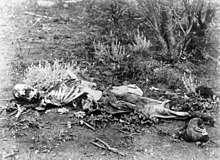
The examination of skeletal remains often takes into account environmental factors that affect decomposition. Forensic taphonomy is the study of these postmortem changes to human remains caused by soil, water, and the interaction with plants, insects, and other animals.[45] In order to study these effects, body farms have been set up by multiple universities. Students and faculty study various environmental effects on the decomposition of donated cadavers. At these locations, cadavers are placed in various situations and their rate of decomposition along with any other factors related to the decomposition process are studied. Potential research projects can include whether black plastic causes decomposition to occur faster than clear plastic or the effects freezing can have on a dumped body.[46]
Forensic taphonomy is divided into two separate sections, biotaphonomy and geotaphonomy. Biotaphonomy is the study of how the environment affects the decomposition of the body. Specifically it is the examination of biological remains in order to ascertain how decomposition or destruction occurred.[47] This can include factors such as animal scavenging, climate, as well as the size and age of the individual at the time of death. Biotaphonomy must also take into account common mortuary services such as embalming and their effects on decomposition.[48]
Geotaphonomy is the examination of how the decomposition of the body affects the environment. Geotaphonomy examinations can include how the soil was disturbed, pH alteration of the surrounding area, and either the acceleration or deceleration of plant growth around the body.[47] By examining these characteristics, examiners can begin to piece together a timeline of the events during and after death. This can potentially help determine the time since death, whether or not trauma on the skeleton was a result of peri or post-mortem activity, as well as if scattered remains were the result of scavengers or a deliberate attempt to conceal the remains by an assailant.[48]
Education
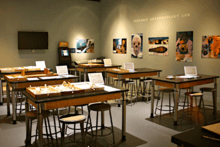
Individuals looking to become forensic anthropologists first obtain a bachelor's degree in anthropology from an accredited university. During their studies they should focus on physical anthropology as well as osteology. In addition it is recommended that individuals take courses in a wide range of sciences such as biology, chemistry, anatomy, and genetics.[49]
Once undergraduate education is completed the individual should proceed to graduate level courses. Typically, forensic anthropologists obtain doctorates in physical anthropology and have completed coursework in osteology, forensics, and archaeology. It is also recommended that individuals looking to pursue a forensic anthropology profession get experience in dissection usually through a gross anatomy class as well as useful internships with investigative agencies or practicing anthropologists.[1] Once educational requirements are complete one can become certified by the forensic anthropology society in the region. This can include the IALM exam given by the Forensic Anthropology Society of Europe[50] or the certification exam given by the American Board of Forensic Anthropology.[51]
Typically, most forensic anthropologists perform forensic casework on a part-time basis, however there are individuals who work in the field full-time usually with federal or international agencies. Forensic anthropologists are usually employed in academia either at a university or a research facility.[52]
Ethics
Like other forensic fields, forensic anthropologists are held to a high level of ethical standards due to their work in the legal system. Individuals who purposefully misrepresent themselves or any piece of evidence can be sanctioned, fined, or imprisoned by the appropriate authorities depending on the severity of the violation. Individuals who fail to disclose any conflict of interests or who fail to report all of their findings, regardless of what they may be, can face disciplinary actions.[53] It is important that forensic anthropologists remain impartial during the course of an investigation. Any perceived bias during an investigation could hamper efforts in court to bring the responsible parties to justice.[54]
In addition to the evidentiary guidelines forensic anthropologists should always keep in mind that the remains they are working with were once a person. If possible, local customs regarding dealing with the dead should be observed and all remains should be treated with respect and dignity.
Notable forensic anthropologists
| Name | Notable for | Ref |
|---|---|---|
| Sue Black | Founding member of the British Association for Human Identification. Director of both the Centre for Anatomy and Human Identification and the Leverhulme Centre for Forensic Science at the University of Dundee. | [55] |
| Karen Ramey Burns | Worked in the investigation of genocides as well as the identification of victims of the 9/11 terrorist attacks and Hurricane Katrina. | [56] |
| Michael Finnegan | Worked on the identification of Jesse James. | [57] |
| Richard Jantz | Co-developer of FORDISC. | [58] |
| Ellis R. Kerley | Worked on the identification of Josef Mengele as well as the victims of the Jonestown mass suicide. | [59] |
| William R. Maples | Worked on the identification of Czar Nicholas II and other members of the Romanov family as well as the examination of President Zachary Taylor's remains for arsenic poisoning. | [60] |
| Fredy Peccerelli | Founder and director of the Guatemalan Forensic Anthropology Foundation. | [61] |
| Kathy Reichs | Inspiration for Temperance "Bones" Brennan of the television show Bones. Also the author of 19 books to date. Most on the subject of forensic anthropology. | [62] |
| Clyde Snow | Worked on the identification of King Tutankhamun and the victims of the Oklahoma City bombing as well as the investigation into the murder of John F. Kennedy. | [63] |
| Mildred Trotter | Created statistical formulas for the calculation of stature based on human long bones through the examination of Korean War casualties. | [64] |
| Kewal Krishan | Advancement of forensic anthropology in India. | [65] |
See also
References
- 1 2 Nawrocki, Stephen P. (June 27, 2006). "An Outline Of Forensic Anthropology" (PDF). Retrieved August 21, 2015.
- ↑ "National Crime Information Center: NCIC Files". FBI. Archived from the original on September 28, 2015. Retrieved September 27, 2015.
- ↑ "Notices". INTERPOL. Retrieved September 27, 2015.
- ↑ McShane, Larry (July 19, 2014). "Forensic pathologist details grim work helping identify bodies after 9/11 in new book". Daily News. Retrieved August 18, 2015.
- ↑ Hinkes, MJ (July 1989). "The role of forensic anthropology in mass disaster resolution". Aviat Space Environ Med. 60: A60–3. PMID 2775124.
- ↑ "College Professor Gets the Call to Examine Plane Crashes and Crime Scenes". PoliceOne. July 28, 2002. Retrieved August 18, 2015.
- ↑ Nuwer, Rachel (November 18, 2013). "Reading Bones to Identify Genocide Victims". The New York Times. Retrieved August 18, 2015.
- ↑ Elson, Rachel (May 9, 2004). "Piecing together the victims of genocide / Forensic anthropologist identifies remains, but questions about their deaths remain". SFGate. Retrieved August 18, 2015.
- ↑ Stewart, T. D. (1979). "In the Uses of Anthropology". Forensic Anthropology. American Anthropological Association. Special Publication (11): 169–183.
- ↑ Shapiro, H. L. (1954). "Earnest Albert Hooton 1887-1954". American Anthropologist. 56: 1081–1084. doi:10.1525/aa.1954.56.6.02a00090.
- ↑ Spencer, Frank (1981). "The Rise of Academic Physical Anthropology in the United States (1880-1980)". American Journal of Physical Anthropology. 56: 353–364. doi:10.1002/ajpa.1330560407.
- 1 2 3 Snow, Clyde Collins (1982). "Forensic Anthropology". Annual Review of Anthropology. 11: 97–131. doi:10.1146/annurev.an.11.100182.000525.
- 1 2 Cobb, W. Montague (1959). "Thomas Wingate Todd, M.B., Ch.B., F.R.C.S. (Eng.), 1885-1938". Journal of the National Medical Association. 51 (3): 233–246. PMC 2641291. PMID 13655086.
- ↑ Buikstra, Jane E.; Ubelaker, Douglas H. (1991). "Standards for Data Collection from Human Skeletal Remains". Arkansas Archaeology Survey Research Series. Arkansas Archaeological Survey. 44.
- ↑ McKern, T. W.; Stewart, T. D. (1957), Skeletal Age Changes in Young American Males (PDF) (Technical Report EP-45), Headquarters, Quartermaster Research and Developmental Command
- ↑ Trotter, M.; Gleser, G.C. (1952). "Estimation of Stature from Long Bones of American Whites and Negroes". American Journal of Physical Anthropology. 10: 463–514. doi:10.1002/ajpa.1330100407.
- ↑ Buikstra, Jane E.; King, Jason L.; Nystrom, Kenneth (2003). "Forensic Anthropology and Bioarchaeology in the American Anthropologist: Rare but Exquisite Gems". American Anthropologist. 105 (1): 38–52. doi:10.1525/aa.2003.105.1.38.
- ↑ Golda, Stephanie (2010). "A Look at the History of Forensic Anthropology: Tracing My Academic Genealogy". Journal of Contemporary Anthropology. 1 (1).
- ↑ "Identification Of Skeletal Remains" (PDF). forensicjournals.com. November 5, 2010. Retrieved August 19, 2015.
- ↑ "4 Ways to Determine Sex (When All You Have is a Skull". Forensic Outreach. October 8, 2012. Retrieved August 19, 2015.
- ↑ Hawks, John (November 15, 2011). "Determining sex from the cranium". Archived from the original on 2015-09-15. Retrieved August 19, 2015.
- ↑ "Differences Between Male Skull and Female Skull". juniordentist.com. September 24, 2008. Retrieved August 19, 2015.
- ↑ "how do archaeologists determine the sex of a skeleton". marshtide. April 27, 2011. Retrieved August 19, 2015.
- ↑ "Male or Female". Smithsonian National Museum of National History. Retrieved August 19, 2015.
- 1 2 "Biological Profile / Stature" (PDF). Simon Fraser University. Retrieved August 19, 2015.
- ↑ Mall, G. (March 1, 2001). "Sex determination and estimation of stature from the long bones of the arm". Forensic Sci Int. 117: 23–30. doi:10.1016/s0379-0738(00)00445-x. PMID 11230943.
- ↑ Hawks, John (September 6, 2011). "Predicting stature from bone measurements". Archived from the original on 2015-09-15. Retrieved August 19, 2015.
- ↑ Garwin, April (2006). "Stature". redwoods.edu. Archived from the original on October 25, 2015. Retrieved August 19, 2015.
- ↑ "Skeletons are good age markers because teeth and bones mature at fairly predictable rates" (PDF). Smithsonian National Museum of Natural History. Retrieved August 20, 2015.
- 1 2 "Young or Old?". Smithsonian National Museum of Natural History. Retrieved August 20, 2015.
- ↑ "Quick Tips: How To Estimate The Chronological Age Of A Human Skeleton — The Basics". All Things AAFS!. August 20, 2013. Retrieved August 20, 2015.
- ↑ "Skeletons as Forensic Evidence". Archived from the original on August 28, 2015. Retrieved August 20, 2015.
- ↑ "Anthropological Views". National Institute of Health. June 5, 2014. Retrieved August 20, 2015.
- ↑ "Analysis of Skeletal Remains". Westport Public Schools. Archived from the original on April 14, 2016. Retrieved August 20, 2015.
- ↑ "Activity: Can You Identify Ancestry?" (PDF). Smithsonian National Museum of Natural History. Retrieved August 20, 2015.
- ↑ "Ancestry, Race, and Forensic Anthropology". Observation Deck. March 31, 2014. Retrieved August 20, 2015.
- ↑ Smith, Ashley C. (December 10, 2010). "Distinguishing Between Antemortem, Perimortem, and Postmortem Trauma". Retrieved August 20, 2015.
- ↑ "Forensic Archaeology". Chicora Foundation. Retrieved August 21, 2015.
- 1 2 3 Schultz, Dupras (2008). "The Contribution of Forensic Archaeology to Homicide Investigations". Homicide Studies. 12: 399–413. doi:10.1177/1088767908324430.
- ↑ Nawrocki, Stephen P. (June 27, 2006). "An Outline Of Forensic Archeology" (PDF). Retrieved August 21, 2015.
- ↑ Sigler-Eisenberg (1985). "Forensic Research: Expanding the Concept of Applied Archaeology". American Antiquity.
- ↑ "Forensic Archaeology". Simon Fraser University. Retrieved August 21, 2015.
- ↑ Haglund, William (2001). "Archaeology and Forensic Death Investigations". Historical Archaeology.
- ↑ Steele, Caroline (2008-08-20). "Archaeology and the Forensic Investigation of Recent Mass Graves: Ethical Issues for a New Practice of Archaeology". Archaeologies. 4 (3): 414–428. doi:10.1007/s11759-008-9080-x. ISSN 1555-8622.
- ↑ Pokines, James; Symes, Steven A. Manual of Forensic Taphonomy. CRC Press. ISBN 9781439878415.
- ↑ Killgrove, Kristina (June 10, 2015). "These 6 'Body Farms' Help Forensic Anthropologists Learn To Solve Crimes". forbes.com. Retrieved August 20, 2015.
- 1 2 "Forensic taphonomy". itsgov.com. December 8, 2011. Retrieved August 20, 2015.
- 1 2 Nawrocki, Stephen P. (June 27, 2006). "An Outline Of Forensic Taphonomy" (PDF). Retrieved August 20, 2015.
- ↑ Hall, Shane. "Education Required for Forensic Anthropology". Retrieved August 21, 2015.
- ↑ "FASE/IALM Certification". Forensic Anthropology Society of Europe. Retrieved August 21, 2015.
- ↑ "Certification Examination General Guidelines" (PDF). American Board of Forensic Anthropology. Archived from the original (PDF) on September 10, 2015. Retrieved August 21, 2015.
- ↑ "ABFA - American Board of Forensic Anthropology". Archived from the original on August 29, 2015. Retrieved August 21, 2015.
- ↑ "Code of Ethics and Conduct" (PDF). Scientific Working Group for Forensic Anthropology. June 1, 2010. Retrieved August 21, 2015.
- ↑ "Code of Ethics and Conduct" (PDF). American Board of Forensic Anthropology. 2012. Archived from the original (PDF) on September 21, 2015. Retrieved August 21, 2015.
- ↑ "About Us". British Association for Human Identification. Retrieved September 28, 2015.
- ↑ Shearer, Lee (January 13, 2012). "Forensic anthropologist Burns dies, a former Athens resident". Retrieved September 28, 2015.
- ↑ Hrenchir, Tim (April 26, 1999). "Scientist who confirmed grave of Jesse James to speak". Retrieved September 28, 2015.
- ↑ Jantz, R.L.; Ousley, S.D. (2005). "FORDISC 3.1 Personal Computer Forensic Discriminant Functions". Archived from the original on September 13, 2015. Retrieved September 28, 2015.
- ↑ Burkhart, Ford (September 12, 1998). "Ellis R. Kerley Is Dead at 74; A Forensic Sherlock Holmes". Retrieved September 28, 2015.
- ↑ Herszenhorn, David M. (March 1, 1997). "William R. Maples, 59, Dies; Anthropologist of Big Crimes". Retrieved September 28, 2015.
- ↑ "Fundación de Antropología Forense de Guatemala". Archived from the original on October 1, 2015. Retrieved September 28, 2015.
- ↑ Moredock, Janet. "Kathy Reichs". Encyclopædia Britannica. Retrieved September 28, 2015.
- ↑ McFadden, Robert (May 16, 2014). "Clyde Snow, Sleuth Who Read Bones From King Tut's to Kennedy's, Dies at 86". Retrieved September 28, 2015.
- ↑ Byers, Steven N. (2011). Introduction to forensic anthropology (4th ed.). Harlow: Pearson Education. p. 490. ISBN 978-0205790128. Retrieved 10 September 2015.
- ↑ "PU Prof, student's study accepted by US forensic sciences academy". Hindustan Times. February 9, 2015. Retrieved June 18, 2016.
External links
- University of Bournemouth
- University of Edinburgh
- University of Dundee
- American Board of Forensic Anthropology
- American Academy of Forensic Sciences
- American Association of Physical Anthropologists
- Maples Center for Forensic Medicine at the University of Florida
- Guatemalan Forensic Anthropology Foundation (in Spanish)
- ForensicAnth.com – Forensic anthropological news stories from across the globe
- The Why Files: Bodies and Bones
- Struers replica technique for forensic investigation
- The Forensic Anthropology Forum – forensic anthropology news and continuing education
- Forensic Anthropology – Theoretical and Practical Information
- Forensic Anthropology Summer Camp – Experience
- Osteointeractive – Forensic Anthropology Blog

